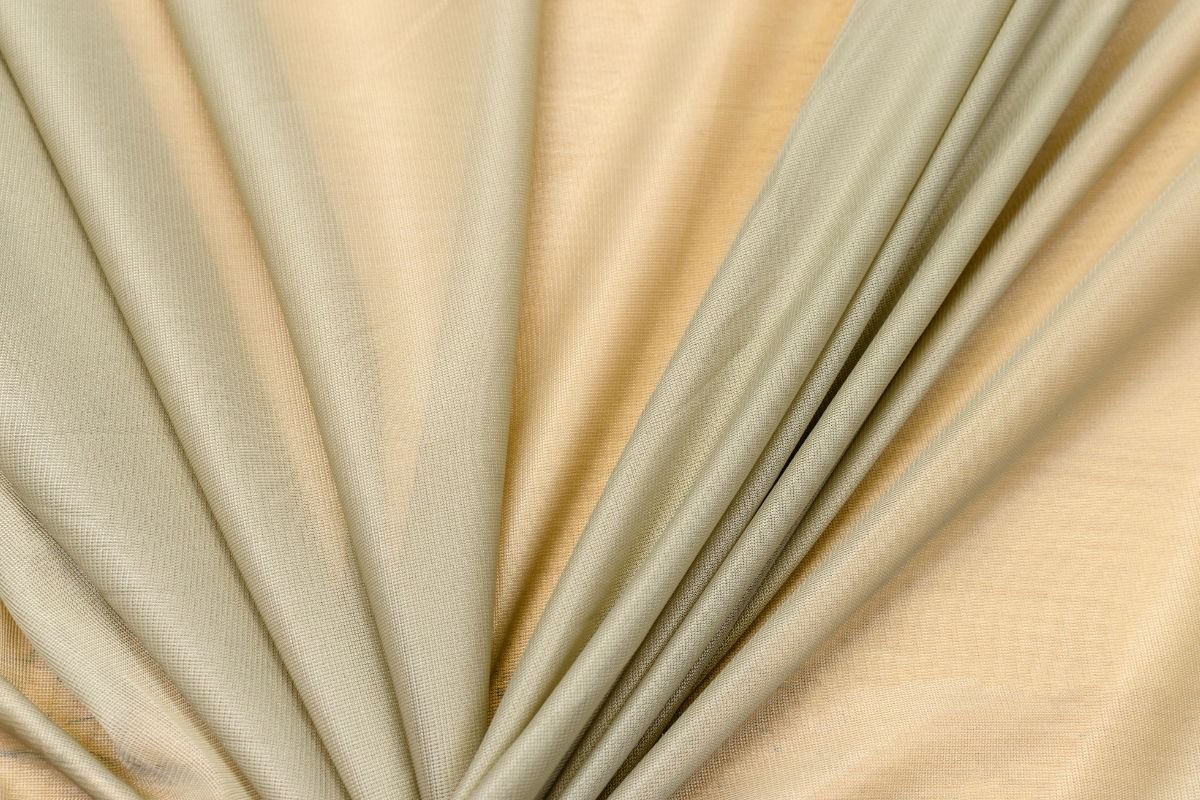Rayon is a material that has many different uses, but despite its versatility, many people know little about rayon and what it is made from.

You might have heard the name ‘rayon’ before, and may have several clothing items, home decor pieces, or accessories that are made out of it.
Rayon also can feel like other fabrics, like wool, cotton, or silk. That cotton-like scarf you love so much may actually be made out of rayon!
As it can resemble other fabrics, it can be difficult to know how to identify it apart from other materials. It’s also hard to understand how to care for it properly and know what weather rayon clothes are best worn in.
You’ll learn what rayon feels like in this post, as well as what rayon is, the main types of rayon, and how to care for the fabric without damaging it.
Rayon: The Basics
The fashion industry uses many different kinds of fabric. From crepe to wool, each material has its own history, properties, and applications.
The majority of materials are classed into two groups. The first is natural materials, like silk, wool, and linen. The second is synthetic materials, like spandex and neoprene.
However, there are a few fabrics that are classed between these two groups. Rayon is an example of these materials that have semi-synthetic fibers.
Rayon is a natural-based fabric created from cellulose sourced from cotton or wood pulp. It’s affordable to work with and can be used for several applications.
Rayon is available in many grades that can mimic the appearance and feel of natural fiber fabrics, like silk, linen, and cotton. It’s available in three main types, lyocell, modal, and viscose.
Rayon may be created from natural fabrics, but it does need specific chemicals, which is why it’s classed as a semi-synthetic material.
Types Of Rayon
Rayon is available the three main types:
Viscose
Viscose is a semi-synthetic variety of rayon created from wood pulp. It is often used as a silk replacement, as the fabric drapes similarly and feels soft, just like silk does.
Viscose is the most common rayon variety and has many uses, from clothing to industrial textiles. It also has the lowest wet strength compared to other rayon types, so it has a greater chance of losing its shape or shrinking in the wash.
Modal
Modal is another semi-synthetic material created from beech tree pulp. It’s mainly used to create clothing items, like pajamas and underwear, along with household products, like towels and bedding.
Modal is typically blended with different fibers, like spandex and cotton, to make it stronger.
The fabric is thought to be a luxurious material as it feels smooth to the touch and costs more than viscose and cotton.
Lyocell
Lyocell is like modal as it is also made from beech tree pulp. The difference here is that the production methods are more eco-friendly and use less harsh chemicals.
Lyocell resembles linen and cotton and is regularly blended with these fabric fibers. It’s also the most absorbent rayon variety, allowing the fabric to take in excess moisture from the skin so it remains cool and dry.
What Rayon Feels Like

Rayon is a soft material that some may describe as silk-like. It also has a smooth feel that resembles linen and cotton. Rayon has a flowing drape, so it hangs and behaves fluidly instead of remaining stiff and rigid.
Rayon’s properties mean that it is a popular fabric choice for several items of clothing. Examples include:
- Drapey clothes. Rayon has a flowing drape quality which is an ideal choice for breathable, fluid, and loose clothing. It works well when creating loose pants and drapey, graceful blouses.
- Athletic clothes. Rayon absorbs moisture well and is a breathable fabric. Rayon athletic wear will keep the wearer comfortable, dry, and cool as they exercise.
- Silky clothes. Rayon has a shiny and smooth feel that resembles silk, except it is a lot more affordable and easier to maintain. This is why rayon is a popular substitute for silk, used to create lingerie, blouses, and bedding. Some even refer to it as art silk or artificial silk.
Pros And Cons Of Rayon
Here are the benefits and drawbacks of rayon.
Pros
- Affordable fabric that appears grand and luxurious to the touch.
- Some types of rayon are known for feeling just like silk
- Drapes fluidly
- Breathable material
- Meshes well with different fabric fibers
- Easy to dye in bold and appealing colors
Cons
- Weaker fabric, especially when moisture or light comes into contact with it
- Greater risk of shrinking in the wash, so it will need to be dry cleaned
- Not as iron-safe as other materials, running the risk of damage
- Manufacturing processes that use harsh chemicals may be harmful to workers and the environment
How To Care For Rayon Properly
Unlike other easy-to-care-for fabrics, you will need to take more care when handling rayon. Rayon is typically blended with different fibers, like cotton or polyester.
This means that its washing guidelines can vary widely between different types of rayon.
Rayon may be versatile and have a desirable texture, but it isn’t a very strong material. General machine washing tasks can make rayon shrink, bleed color, or stretch out, losing its form.
Here are a few tips that can help prevent damage to your rayon items of clothing.
- Never wash the rayon with very hot water. Select silk or wool wash settings that don’t exceed 86°F (30°C), unless the garment’s tag states otherwise.
- Always check the garment’s label for the recommended instructions, as they might need to be washed at a different temperature. You may need to wash rayon by hand or opt for a much colder wash.
- You can tumble dry rayon, just ensure that you stick to a cooler setting. Higher temperatures can make the material shrink.
- Rayon can be ironed, provided you stick to a lower setting.
The Bottom Line
Rayon is a multipurpose fabric that is available in three main types, viscose, lyocell, and modal. It can replicate the feel of different materials, like silk and cotton, popular for their soft and smooth texture.
Rayon is more affordable than silk, but it needs to be cared for properly. Higher temperatures can make the fabric shrink in the dryer or wash, so it’s best to stick to cooler settings or wash by hand.
- 15 Amazing Vegan UGG Boots Not To Miss Out On - November 23, 2022
- 15 Vegan Running Shoes To Brighten Up Your Wardrobe - November 23, 2022
- 8 Best VEJA Vegan Sneakers To Buy Today - November 22, 2022










